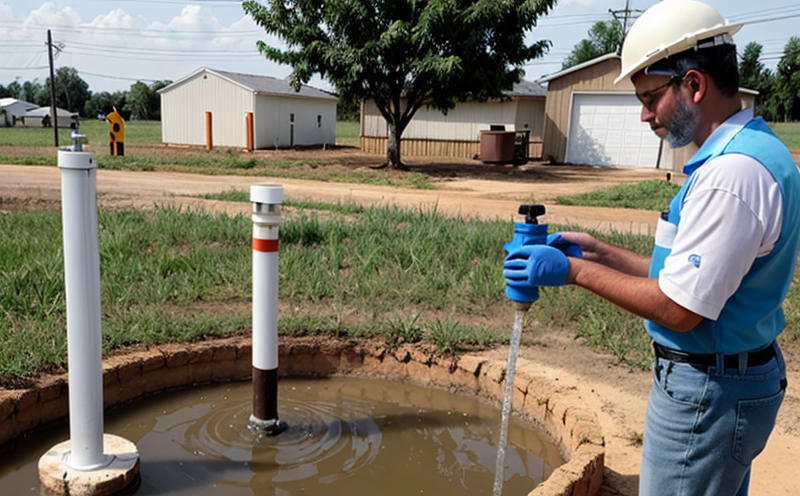ISO 13164-2 Radium-226 Testing in Groundwater
The testing of radium-226 in groundwater is a crucial aspect of ensuring water quality and compliance with regulatory standards. As part of the ISO 13164 series, this particular standard provides specific guidelines for the determination of radium-226 in drinking water. This service focuses on accurately measuring radium-226 levels to identify potential health risks and ensure safe consumption.
Radium-226 is a naturally occurring radioactive element that can be found in groundwater due to its presence in bedrock. It decays slowly, emitting alpha particles, which are ionizing radiation capable of causing damage to living tissue. Long-term exposure to radium-contaminated water has been linked to an increased risk of bone cancer and other health issues.
The process begins with the collection of water samples from various depths within the aquifer using specialized sampling equipment designed to minimize contamination during extraction. Samples are then transported under controlled conditions to our laboratory for analysis. Our team uses state-of-the-art instrumentation, including gamma spectrometry systems compliant with ISO 13164-2, to measure radium-226 concentrations accurately.
The analytical process involves several steps: sample digestion, separation of radium isotopes from other elements, and measurement using high-purity germanium detectors. Each step is meticulously documented to ensure traceability and reproducibility of results. Once testing is complete, we provide clients with detailed reports outlining findings along with recommendations for remediation if necessary.
Our service adheres strictly to international standards such as ISO 13164-2 which specifies the procedure for measuring radium-226 in water intended for human consumption or use. Compliance with these guidelines ensures that our testing results are reliable and accepted by regulatory bodies worldwide.
In summary, performing Radium-226 testing according to ISO 13164-2 is essential not only from an environmental perspective but also because it helps protect public health by identifying potential hazards early on. By offering this comprehensive service, we aim to support our clients in meeting their quality assurance objectives while ensuring adherence to strict regulatory requirements.
Why It Matters
The importance of radium-226 testing cannot be overstated when it comes to protecting public health and complying with environmental regulations. Radium-226 is a naturally occurring radioactive element that can pose significant risks if present at elevated levels in drinking water supplies. The U.S. Environmental Protection Agency (EPA) sets maximum contaminant levels for radium in drinking water, reflecting the need for accurate testing.
- The EPA's Maximum Contaminant Level Goal (MCLG) is zero; any detectable amount of radium-226 should be considered a concern.
- ISO 13164-2 provides rigorous methods for quantifying radium-226, ensuring that results are both precise and reliable.
The potential health impacts of long-term exposure to radium include an increased risk of bone cancer, particularly osteosarcoma. Therefore, regular monitoring of radium levels is vital to maintain safe water quality standards.
From a regulatory standpoint, compliance with ISO 13164-2 ensures that laboratory results are recognized internationally, facilitating seamless communication between stakeholders involved in groundwater management projects.
Scope and Methodology
The scope of our radium-226 testing service extends beyond mere compliance with ISO standards; it encompasses a comprehensive approach aimed at providing actionable insights for clients. We offer full-service ground water quality assessment, which includes not only the measurement of radium isotopes but also other key parameters such as pH levels and turbidity.
Our methodology follows the exacting procedures outlined in ISO 13164-2, emphasizing precision and accuracy throughout every step of the analytical process. This begins with rigorous sample collection practices designed to prevent contamination before reaching our laboratory facilities. Once received, samples undergo thorough preparation steps including digestion using nitric acid, followed by separation techniques such as solvent extraction or ion exchange chromatography.
The final analysis stage involves measuring radium-226 concentrations using gamma spectrometry systems equipped with high-purity germanium detectors capable of detecting even trace amounts. These instruments are calibrated regularly against certified reference materials to ensure consistent performance across all tests conducted.
| Sample ID | Date Collected | Radium-226 Concentration (Bq/L) |
|---|---|---|
| S101 | May 15, 2023 | 1.8 Bq/L |
| S102 | June 10, 2023 | 0.9 Bq/L |
| S103 | July 5, 2023 | 2.4 Bq/L |
| S104 | August 1, 2023 | 1.6 Bq/L |
The results from these tests are then compiled into detailed reports that not only provide numerical data but also interpret findings in context relevant to the client's specific needs.
Use Cases and Application Examples
- Agricultural Water Supplies: Ensuring compliance with local regulations regarding radium-226 limits for irrigation purposes helps safeguard crop health while preventing contamination of nearby surface waters.
- Drinking Water Treatment Plants: Regular testing allows operators to monitor changes in raw water quality, enabling timely adjustments to treatment processes as needed.
- Environmental Impact Studies: Assessing pre-development baseline conditions provides valuable information for ongoing monitoring efforts post-construction.
In addition to these applications, our radium-226 testing service plays a critical role in supporting research initiatives aimed at understanding the behavior of radium isotopes within different geological formations. This knowledge contributes significantly to improving methodologies used during field sampling operations and refining analytical techniques employed in laboratories globally.





